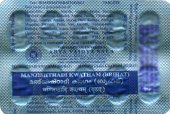Mahanimba, Mahānimba, Maha-nimba: 9 definitions
Introduction:
Mahanimba means something in Hinduism, Sanskrit, Marathi, biology. If you want to know the exact meaning, history, etymology or English translation of this term then check out the descriptions on this page. Add your comment or reference to a book if you want to contribute to this summary article.
In Hinduism
Ayurveda (science of life)
Cikitsa (natural therapy and treatment for medical conditions)
Source: Wisdom Library: Ayurveda: CikitsaMahānimba (महानिम्ब) is a Sanskrit word referring to Melia azedarach, a species of deciduous tree from the Meliaceae (mahogany) family of flowering plants. English names include “white cedar”, “chinaberry tree” or “Indian lilac”. It is used throughout Ayurvedic literature such as the Caraka-saṃhitā and the Suśruta-saṃhitā.
This plant (Mahānimba) is also possibly identified with Mūrvā, a medicinal used for the treatment of all major fevers (jvara), as described in the Jvaracikitsā (or “the treatment of fever”) which forms the first chapter of the Sanskrit work called Mādhavacikitsā. In this work, the plant is mentioned being part of the Nimbayugma group of medicinal drugs.
Unclassified Ayurveda definitions
Source: Google Books: Essentials of AyurvedaMahānimba (महानिम्ब, “great nimba”).—The Sanskrit name for an important Ayurvedic drug combination.—It is also called as ‘Parvatanimba’ because it grows commonly in hilly area. It is bitter and astringent. The seeds are used in liver disorders, piles, kuṣṭha and prameha.

Āyurveda (आयुर्वेद, ayurveda) is a branch of Indian science dealing with medicine, herbalism, taxology, anatomy, surgery, alchemy and related topics. Traditional practice of Āyurveda in ancient India dates back to at least the first millenium BC. Literature is commonly written in Sanskrit using various poetic metres.
Biology (plants and animals)
Source: Google Books: CRC World Dictionary (Regional names)1) Mahanimba in India is the name of a plant defined with Ailanthus excelsa in various botanical sources. This page contains potential references in Ayurveda, modern medicine, and other folk traditions or local practices It has the synonym Pongelion excelsum (Roxb.) Pierre (among others).
2) Mahanimba is also identified with Ailanthus triphysa It has the synonym Ailanthus triphysa Alston (etc.).
3) Mahanimba is also identified with Melia azedarach It has the synonym Azedaraca amena Raf. (etc.).
Example references for further research on medicinal uses or toxicity (see latin names for full list):
· A General History of the Dichlamydeous Plants (1831)
· FBI (1875)
· Species Plantarum (1753)
· Journal of Cytology and Genetics (1984)
· A Handbook to the Flora of Ceylon (1931)
· Indian Assimilation in the Franciscan Area of Nueva Vizcaya. (1979)
If you are looking for specific details regarding Mahanimba, for example chemical composition, pregnancy safety, extract dosage, diet and recipes, side effects, health benefits, have a look at these references.

This sections includes definitions from the five kingdoms of living things: Animals, Plants, Fungi, Protists and Monera. It will include both the official binomial nomenclature (scientific names usually in Latin) as well as regional spellings and variants.
Languages of India and abroad
Marathi-English dictionary
Source: DDSA: The Molesworth Marathi and English Dictionarymahānimba (महानिंब).—m (S) A tree, Melia sempervirens.
Marathi is an Indo-European language having over 70 million native speakers people in (predominantly) Maharashtra India. Marathi, like many other Indo-Aryan languages, evolved from early forms of Prakrit, which itself is a subset of Sanskrit, one of the most ancient languages of the world.
Sanskrit dictionary
Source: Cologne Digital Sanskrit Dictionaries: Shabda-Sagara Sanskrit-English DictionaryMahānimba (महानिम्ब).—m.
(-mbaḥ) A large kind of Nimba tree, (Melia sempervirens.) E. mahā great, and nimba the Nimba. “ghoḍānim .”
Source: Cologne Digital Sanskrit Dictionaries: Monier-Williams Sanskrit-English DictionaryMahānimba (महानिम्ब):—[=mahā-nimba] [from mahā > mah] m. Melia Bukajun, [Suśruta]
Source: Cologne Digital Sanskrit Dictionaries: Yates Sanskrit-English DictionaryMahānimba (महानिम्ब):—[mahā-nimba] (mbaḥ) 1. m. Large Nimb tree.
[Sanskrit to German]
Sanskrit, also spelled संस्कृतम् (saṃskṛtam), is an ancient language of India commonly seen as the grandmother of the Indo-European language family (even English!). Closely allied with Prakrit and Pali, Sanskrit is more exhaustive in both grammar and terms and has the most extensive collection of literature in the world, greatly surpassing its sister-languages Greek and Latin.
See also (Relevant definitions)
Starts with: Mahanimbaraja, Mahanimbarajas.
Full-text: Mahanimbarajas, Vishamushtika, Maharishta, Keshamushti, Pavaneshta, Nimbayugma, Kakanda, Udreka, Parvata, Sumedha.
Relevant text
Search found 4 books and stories containing Mahanimba, Maha-nimba, Mahā-nimba, Mahānimba; (plurals include: Mahanimbas, nimbas, Mahānimbas). You can also click to the full overview containing English textual excerpts. Below are direct links for the most relevant articles:
Chaitanya Bhagavata (by Bhumipati Dāsa)
Verse 2.10.313 < [Chapter 10 - Conclusion of the Lord’s Mahā-prakāśa Pastimes]
Rasa Jala Nidhi, vol 4: Iatrochemistry (by Bhudeb Mookerjee)
Part 16 - Treatment for diarrhea (7): Naga-sundara rasa < [Chapter III - Jvaratisara fever with diarrhoea]
Part 27 - Diet in diarrhoea < [Chapter III - Jvaratisara fever with diarrhoea]
Atharvaveda and Charaka Samhita (by Laxmi Maji)
5b. Kṛmi (Worms) in the Atharvaveda < [Chapter 5 - Diseases and Remedies in Atharvaveda and Caraka-Saṃhitā]
Sushruta Samhita, volume 3: Sharirasthana (by Kaviraj Kunja Lal Bhishagratna)
Related products





